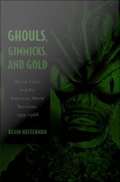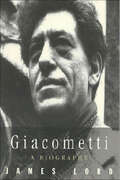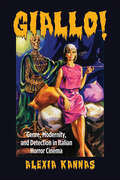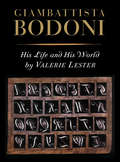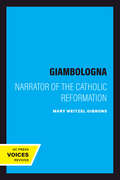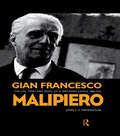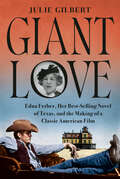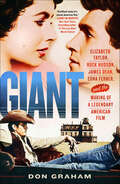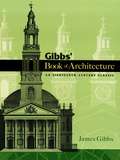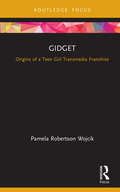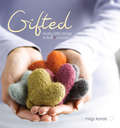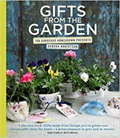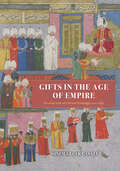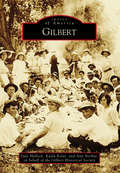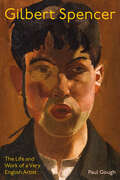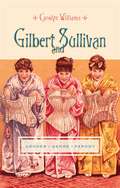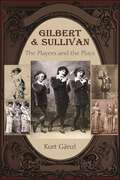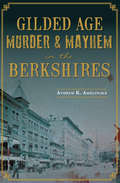- Table View
- List View
Ghouls, Gimmicks, and Gold: Horror Films and the American Movie Business, 1953-1968
by Kevin HeffernanThe Creature from the Black Lagoon, the Tingler, the Mole People--they stalked and oozed into audiences' minds during the era that followed Boris Karloff's Frankenstein and preceded terrors like Freddy Krueger (A Nightmare on Elm Street) and Chucky (Child's Play). Ghouls, Gimmicks, and Gold pulls off the masks and wipes away the slime to reveal how the monsters that frightened audiences in the 1950s and 1960s--and the movies they crawled and staggered through--reflected fundamental changes in the film industry. Providing the first economic history of the horror film, Kevin Heffernan shows how the production, distribution, and exhibition of horror movies changed as the studio era gave way to the conglomeration of New Hollywood. Heffernan argues that major cultural and economic shifts in the production and reception of horror films began at the time of the 3-d film cycle of 1953-54 and ended with the 1968 adoption of the Motion Picture Association of America's ratings system and the subsequent development of the adult horror movie--epitomized by Rosemary's Baby. He describes how this period presented a number of daunting challenges for movie exhibitors: the high costs of technological upgrade, competition with television, declining movie attendance, and a diminishing number of annual releases from the major movie studios. He explains that the production and distribution branches of the movie industry responded to these trends by cultivating a youth audience, co-producing features with the film industries of Europe and Asia, selling films to television, and intensifying representations of sex and violence. Shining through Ghouls, Gimmicks, and Gold is the delight of the true horror movie buff, the fan thrilled to find The Brain that Wouldn't Die on television at 3 am.
Giacometti: A Biography
by James LordThe work of one of the towering creative spirits of the century, Alberto Giacometti's visionary sculptures and paintings from a testament to the artist's intriguing life story. From modest beginnings in a Swiss village, Giacometti went on to flourish in the picturesque milieu of prewar Paris and then to achieve international acclaim in the fifties and sixties. Picasso, Balthus, Samuel Beckett, Stravinsky and Sartre have parts in his story, along with flamboyant art dealers, whores, shady drifters, unscrupulous collectors, poets and thieves. Women were a complex yet important element of his life--particularly his wife, Annette, and his last mistress and model, Caroline--as was the intimate relationship he shared with his brother Diego, who was both Alberto's confidant and collaborator.James Lord was personally acquainted with Giacometti and his entourage, and combines firsthand experience with a unique knowledge gathered during many years of observation and research. In this exceptional biography Lord unfolds the personal history of a man who managed to achieve a heroic destiny by remaining utterly true to himself and to his calling.Giacometti: A Biography was nominated for the National Book Critics Circle Award. James Lord has subsequently published three volumes of memoirs. In recognition of his contribution to French culture he has been made an officer of the Legion of Honour.
Giallo!: Genre, Modernity, and Detection in Italian Horror Cinema (SUNY series, Horizons of Cinema)
by Alexia KannasItalian giallo films have a peculiar allure. Taking their name from the Italian for "yellow"— reflecting the covers of pulp crime novels—these genre movies were principally produced between 1960 and the late 1970s. These cinematic hybrids of crime, horror, and detection are characterized by elaborate set-piece murders, lurid aesthetics, and experimental soundtracks. Using critical frameworks drawn from genre theory, reception studies, and cultural studies, Giallo! traces this historically marginalized genre's journey from Italian cinemas to the global cult-film canon. Through close textual analysis of films including The Girl Who Knew Too Much (1963), Blood and Black Lace (1964), The Bird with the Crystal Plumage (1970), The Black Belly of the Tarantula (1971), and The Case of the Bloody Iris (1972), Alexia Kannas considers the rendering of urban space in the giallo and how it expresses a complex and unsettling critique of late modernity.
Giambattista Bodoni: His Life And His World
by Valerie LesterThis is the first English-language biography of the relentlessly ambitious and incomparably talented printer Giambattista Bodoni (1740-1813). Born to a printing family in the small foothill town of Saluzzo, he left his comfortable life to travel to Rome in 1758 where he served as an apprentice of Cardinal Spinelli at the Propaganda Fide press. There, under the sponsorship of Ruggieri, he learned all aspects of the printing craft. Even then, his real talent lay in type design and punchcutting, especially of the exotic foreign alphabets needed by the papal office to spread the faith. His life changed when at age 28 he was invited by the Duke of Parma to abandon Rome for that very French city to establish and direct the ducal press. He remained in Parma, overseeing a vast variety of printing, some of it pedestrian, but much of it glorious. And all of it making use of the typefaces he personally designed and engraved. This fine book goes beyond Bodoni's capacity as a printer; it examines the life and times in which he lived, the turbulent and always fragile political climate, the fascinating cast of characters that enlivened the ducal court, the impressive list of visitors making the pilgrimage to Parma, and the unique position Parma occupied, politically Italian but very much French in terms of taste and culture. Even the food gets its due. The illustrations—of the city, of the press, of the types and matrices—are captivating, but most striking are the pages from the books he designed, especially pages from his typographic masterpiece, the Manuale Tipografico, which displayed the myriad typefaces in multiple sizes that Bodoni had designed and engraved over a long and prolific career. Intriguing, scholarly, visually arresting, and designed and printed to Bodoni's standards, this title belongs on the shelf of any self-respecting bibliophile. It not only makes for compelling reading, it will be considered the biography of record of a great printer for years to come.
Giambologna: Narrator of the Catholic Reformation (California Studies in the History of Art #33)
by Mary Weitzel GibbonsThis title is part of UC Press's Voices Revived program, which commemorates University of California Press’s mission to seek out and cultivate the brightest minds and give them voice, reach, and impact. Drawing on a backlist dating to 1893, Voices Revived makes high-quality, peer-reviewed scholarship accessible once again using print-on-demand technology. This title was originally published in 1995.This title is part of UC Press's Voices Revived program, which commemorates University of California Press’s mission to seek out and cultivate the brightest minds and give them voice, reach, and impact. Drawing on a backlist dating to 1893, Voices Revived</DIV
Gian Francesco Malipiero: The Life, Times and Music of a Wayward Genius (Contemporary Music Studies #Vol. 17)
by John C. WaterhouseIn recent years Gian Francesco Malipiero has been recognised increasingly widely as one of the most original and strangely fascinating Italian composers of the early 20th century. He was the teacher of Maderna and Nono, and was revered by (among many others) Dallapiccola, who even called him the most important (musical) personality that Italy has had since the death of Verdi . He was also a key figure in the revival of the long- neglected music of Italy's great past, and himself edited what remains the only virtually complete edition of the surviving compositions of Monteverdi. The present book not only provides the first monographic survey of Malipiero's life, times and music to appear in English, but covers the subject more comprehensively than any previous publication in any language. Dr Waterhouse draws on hitherto unpublished documents, and with the help of numerous musical examples, analyses the composer's works, style and idiosyncratic personality.
Giant Love: Edna Ferber, Her Best-selling Novel of Texas, and the Making of a Classic American Film
by Julie GilbertTHE NEW YORK TIMES BOOK REVIEW EDITORS' CHOICE • A book that explores the great American novelist and playwright Edna Ferber, winner of the Pulitzer Prize for Ficton, whose work was made into many Academy Award-winning movies; the writing of her controversial, international best-selling novel about Texas, and the making of George Stevens&’ Academy Award winning epic film of the same name, Giant.The stupendous publication of Edna Ferber's Giant in 1952 set off a storm of protest over the novel's portrayal of Texas manners, money and mores with oil-rich Texans threatening to shoot, lynch or ban Ferber from ever entering the state again.In Giant Love, Julie Gilbert writes of the internationally best-selling Ferber, one of the most widely read writers in the first half of the 20th Century – her evolution from mid-west maverick girl-reporter to Pulitzer Prize winning, beloved American novelist, from her want-to-be actress days to becoming Broadway's acclaimed prize-winning playwright whose collaborators – George S. Kauffman and Moss Hart, among them, were, along with Ferber, herself, the most successful playwrights of their time.Here is the making of an American classic novel and the film that followed in its wake. We see how George Stevens, Academy-Award winning director, wooed the prickly, stubborn Ferber, ultimately getting her to agree to everything including writing, for the first time ever, a draft of a screenplay, to her okaying James Dean for the part of the ranch hand, Jett Rink, something she was dead set against.Here is the casting of Elizabeth Taylor, Rock Hudson, James Dean and their backstory triangle of sex and seduction – each becoming a huge star because of the film; the frustrated Stevens trying to direct the instinctive but undisciplined Dean, and the months long landmark filming in the sleepy town of Marfa, Texas, suddenly invaded by a battalion of a film crew and some of the biggest stars in the rising celebrity culture.
Giant: Elizabeth Taylor, Rock Hudson, James Dean, Edna Ferber, and the Making of a Legendary American Film
by Don GrahamA larger-than-life narrative of the making of the classic film, marking the rise of America as a superpower, the ascent of Hollywood celebrity, and the flowering of Texas culture as mythology.Featuring James Dean, Rock Hudson, and Elizabeth Taylor, Giant is an epic film of fame and materialism, based around the discovery of oil at Spindletop and the establishment of the King Ranch of south Texas. Isolating his star cast in the wilds of West Texas, director George Stevens brought together a volatile mix of egos, insecurities, sexual proclivities, and talent. Stevens knew he was overwhelmed with Hudson’s promiscuity, Taylor’s high diva-dom, and Dean’s egotistical eccentricity. Yet he coaxed performances out of them that made cinematic history, winning Stevens the Academy Award for Best Director and garnering nine other nominations, including a nomination for Best Actor for James Dean, who died before the film was finished. In this compelling and impeccably researched narrative history of the making of the film, Don Graham chronicles the stories of Stevens, whose trauma in World War II intensified his ambition to make films that would tell the story of America; Edna Ferber, a considerable literary celebrity, who meets her match in the imposing Robert Kleberg, proprietor of the vast King Ranch; and Glenn McCarthy, an American oil tycoon; and Errol Flynn lookalike with a taste for Hollywood. Drawing on archival sources Graham’s Giant is a comprehensive depiction of the film’s production showing readers how reality became fiction and fiction became cinema.
Gibbs' Book of Architecture: An Eighteenth-Century Classic
by James GibbsOne of England's most respected and influential architects, James Gibbs was born in Scotland, studied in Rome, and left a legacy of design the world will treasure forever. His legendary 1728 folio, a sprawling gallery of Gibbs's magnificent drawings, perspectives, and blueprints, is a brilliant testimony to his remarkable talent. Profusely illustrated, the volume features such notable commissions as London's St. Martin in the Fields -- the inspiration for many steeple churches of the colonial period in America; St. Mary le Strand, his first public building; Marybone Chapel; The Church of Allhallows in Derby; plus Gibbs's first commission, an addition for King's College at Cambridge. His most outstanding accomplishment may be the circular Radcliffe Library at Oxford, for which he received a Master of Arts. Also included here are detailed floor plans, plus fine drawings of decorative marble cisterns, ornamental iron gates, stately funeral monuments, and much more. Essential for an understanding of classic architecture, this stunning edition should grace the bookshelf of every architect, as well as architectural students, teachers, and historians.
Gidget: Origins of a Teen Girl Transmedia Franchise (Cinema and Youth Cultures)
by Pamela Robertson WojcikGidget: Origins of a Teen Girl Transmedia Franchise examines the multiplicity of books, films, TV shows, and merchandise that make up the transmedia Gidget universe from the late 1950s to the 1980s. The book examines the Gidget phenomenon as an early and unique teen girl franchise that expands understanding of both teen girlhood and transmedia storytelling. It locates the film as existing at the historical intersection of numerous discourses and events, including the emergence of surf culture and surf films; the rise of California as signifier of modernity and as the epicentre of white American middle-class teen culture; the annexation of Hawaii; the invention of Barbie; and Hollywood’s reluctant acceptance of teen culture and teen audiences. Each chapter places the Gidget text in context, looking at production and reception circumstances and intertexts such as the novels of Françoise Sagan, the Tammy series, La Dolce Vita, and The Patty Duke Show, to better understand Gidget’s meaning at different points in time. This book explores many aspects of Gidget, providing an invaluable insight into this iconic franchise for students and researchers in film studies, feminist media studies, and youth culture.
Gifted: Lovely Little Things to Knit and Crochet
by Mags KandisThere’s nothing quite like receiving a handmade gift, and your family and friends will love being on the receiving end of these handmade designs. Designer Mags Kandis inspires with this delightful collection of beautiful and colorful little projects for you to knit, crochet, and felt. From wearable accessories such as hats, mittens, scarves, socks, and wraps to home decor including a tea cozy, pin cushion, needle case, and laptop cover, these 30+ pieces are sweet, lively and add a little joy to every household. Each project features creative embellishments and personal touches, including beading, buttons, needlefelting, appliqué, and embroidery. Mags also shares her recipes for easy food gifts and simple sewing projects such as sewn fabric gift bags and sachets to pair with fiber gifts. Directions for making these little add-ons that make a gift personal and extra-special are scattered throughout the book. Giftedwill inspire you to grab another ball of yarn and invest a little time and love to create something special for someone special.
Gifts and Gadgets
by Amy YoheAbeka’s Gifts and Gadgets reader engages your child with stories, poems, and nonfiction passages that inspire innovation and creativity as they compare inventions of the past with modern technology. As a reader in Abeka’s Grade 4 Language Arts program, each story’s questions and write-in activities focus on reading comprehension and critical thinking. Selections will broaden vocabulary and build reading skills. Literary concepts, like problem/solution text structure and point of view with first and third person passages, are highlighted. and text structures are reviewed.
Gifts from Georgia's Garden: How Georgia O'Keeffe Nourished Her Art
by Lisa RobinsonCome behind the scenes of Georgia O&’Keeffe&’s famous flower paintings to her sustainable homestead in New Mexico, where art was everything and everything was art.Most of us have heard the name Georgia O&’Keeffe— she&’s one of the most famous women in art history. But did you know that for most of her life, she lived on her own land in New Mexico, grew her own food, bought locally, and even made her own clothing?Georgia&’s garden and her art fed and enriched one another, just as her bean plants enriched the soil and her home-grown feasts fed her friends. In spite of the era&’s prejudice against female artists, Georgia lived and thrived in her verdant sanctuary well into old age. Soothing and inspiring, Gifts from Georgia&’s Garden illuminates the life and philosophy of a figure every child should know. Backmatter adds context to O&’Keeffe&’s story and invites families to try out her sustainable gardening techniques— and her pecan butterball cookies.Gifts for Georgia&’s Garden is the latest in Lisa Robinson&’s collection of thoughtful, artfully-told picture book biographies on figures who broke the mold and made history because of it. Hadley Hooper, a painter in her own right and the illustrator of books about Matisse (The Iridescence of Birds) and Giacometti (Two Brothers, Four Hands), perfectly evokes Georgia O&’Keeffe&’s style with pictures that burst with color and life.
Gifts from the Garden
by Debora RobertsonBrimming with ideas from the pretty to the practical, Gifts from the Garden contains more than 100 projects that use the gardener's bounty throughout the seasons. Divided into Flowers and Herbs, and Fruit and Vegetables, Debora includes gifts that are edible, for your home and for your wellbeing. There are potted bulbs in teacups and decorated personal seed packets, a lavender, rose and chamomile bubble bath, flower and fruit lip balms, a tisane planter and a pizza herb window box, as well as festive wreaths and ideas for using flowers and foliage when wrapping presents. And of course delicious ideas like toffee apples, herbal teas, spice rubs, chilli jams, courgette muffins and quince vodka to name a few! So whether you want to give something practical for the home, indulgent to enjoy at bath time, or to complement a delicious dinner, there is a present that will suit everyone.
Gifts from the Garden
by Debora RobertsonBrimming with ideas from the pretty to the practical, Gifts from the Garden contains more than 100 projects that use the gardener's bounty throughout the seasons. Divided into Flowers and Herbs, and Fruit and Vegetables, Debora includes gifts that are edible, for your home and for your wellbeing. There are potted bulbs in teacups and decorated personal seed packets, a lavender, rose and chamomile bubble bath, flower and fruit lip balms, a tisane planter and a pizza herb window box, as well as festive wreaths and ideas for using flowers and foliage when wrapping presents. And of course delicious ideas like toffee apples, herbal teas, spice rubs, chilli jams, courgette muffins and quince vodka to name a few! So whether you want to give something practical for the home, indulgent to enjoy at bath time, or to complement a delicious dinner, there is a present that will suit everyone.
Gifts in Jars: Homemade Cookie Mixes, Soup Mixes, Candles, Lotions, Teas, and More!
by Natalie WiseLearn to make dozens of unique gifts packaged perfectly in glass jars of various shapes and sizes. Do you have an aspiring gardener on your list? Make a "plant bomb" jar with your favorite flower seeds or an adorable terrarium featuring easy-to-grow air plants. Headed to a bridal shower? Pamper your friend with a manicure kit or mint mojito lip scrub. Who wouldn't love some homemade sugar cookie mix or healthy and delicious granola in an attractive and reusable jar?Glass jars are easy to come by, cute, and incredibly versatile. Fill them with customized treasures to delight anyone on your list. Projects include:Light-Up Fairy JarBarbecue RubHot Fudge ToppingSnowglobe ScenesVanilla Citrus Sugar Hand ScrubCitronella Oil LampBird FeederAnd more!Complete with tips for decorating jars, suggestions for gift tags, and inspiring full-color photographs, Gifts in Jars is here to make your holiday gift list a whole lot more fun.
Gifts in the Age of Empire: Ottoman-Safavid Cultural Exchange, 1500–1639 (Silk Roads)
by Sinem Arcak CasaleExplores the Safavid and Ottoman empires through the lens of gifts. When the Safavid dynasty, founded in 1501, built a state that championed Iranian identity and Twelver Shi'ism, it prompted the more established Ottoman Empire to align itself definitively with Sunni legalism. The political, religious, and military conflicts that arose have since been widely studied, but little attention has been paid to their diplomatic relationship. Sinem Arcak Casale here sets out to explore these two major Muslim empires through a surprising lens: gifts. Countless treasures—such as intricate carpets, gilded silver cups, and ivory-tusk knives—flowed from the Safavid to the Ottoman Empire throughout the sixteenth century. While only a handful now survive, records of these gifts exist in court chronicles, treasury records, poems, epistolary documents, ambassadorial reports, and travel narratives. Tracing this elaborate archive, Casale treats gifts as representative of the complicated Ottoman-Safavid coexistence, demonstrating how their rivalry was shaped as much by culture and aesthetics as it was by religious or military conflict. Gifts in the Age of Empire explores how gifts were no mere accessories to diplomacy but functioned as a mechanism of competitive interaction between these early modern Muslim courts.
Gig Posters Volume 2: Rock Show Art of the 21st Century
by Clay HayesReaders gave the first Gig Posters anthology a standing ovation—so for your viewing pleasure, here’s one heck of an encore: 700 more incredible posters from the archives of GigPosters.com, the Internet’s premier destination for concert poster art. It’s a mad jam of illustration and photography, collage and typography, bringing the contemporary music scene to exciting visual life for a generation of fans who’ve grown up in the post-album-art era.Gig Posters Volume 2 showcases bold artistic riffing by a hundred of today’s most talented designers, including David V. D’Andrea, Peter Cardoso, Graham Pilling, Tyler Stout, Marq Spusta, and Nashville’s legendary Hatch Show Print. You’ll peek inside their portfolios and hear the backstage stories of how these incredible art-and-music creations came to be.You’ll also find 101 perforated and ready-to-frame posters promoting the most dynamic musical acts of the twenty-first century, from the Black Keys, Flight of the Conchords, Ice-T, and My Morning Jacket to Norah Jones, the Avett Brothers, Coheed & Cambria, and many, many more.It’s an awesome compendium of pop-art-history in the making—and it’s also just what the walls of your apartment or office have been waiting for.
Gil Walsh Interiors: A Case for Color
by Gil Walsh Margaret Reilly MuldoonThe award-winning interior designer and owner of Gil Walsh Interiors shares her colorful approach to style in this beautifully illustrated volume. Master colorist Gil Walsh has spent decades bringing her expertise to elegant homes from Pennsylvania to West Palm Beach, Martha&’s Vineyard, and beyond. Now she brings readers into her creative process, showing how she helps clients express their personal lifestyles through inviting and gorgeously vibrant interiors. With stunning photography, this volume demonstrates how color can be enjoyed with gusto, whether in pretty pastels or bold, bright hues. From beach houses in the Florida Keys to sky-scraping apartments in Palm Beach, historic landmark buildings such as Fallingwater and the Duquesne Club in Pennsylvania, and a cozy cottage on Martha&’s Vineyard, Gil has applied her artistic eye and techniques to a wide variety of interiors and period styles.
Gilbert
by Dale Hallock Kayla Kolar Gilbert Historical Society Ann NorbutGilbert is one of the fastest growing communities in the country. There were only 500 residents when the town was incorporated in 1920. Since 1980, the population has doubled every five years. But how did this small desert community come to have such explosive growth in just over 30 years? Early pioneers began arriving in 1890, and in 1902, the Arizona Eastern Railway decided to build a rail line from Phoenix that went through Florence to the mining town of Kelvin. After purchasing land from Bobby Gilbert, a depot was built in 1905, and the town began to grow. Because of the creation of canals and Roosevelt Dam, Gilbert became a thriving agricultural community. In 1971, Gilbert had less than 2,000 residents, and in 1975, the town council approved a land annexation that added over 53 square miles to Gilbert. In 2014, that population number approached 250,000. By 2040, Gilbert is expected to be the fourth largest community in Arizona with approximately 330,000 residents.
Gilbert Spencer: The Life and Work of a Very English Artist
by Sacha Llewellyn Amanda Bradley PetitgasThe first biography of Gilbert Spencer, recounting the life and career of a long-overlooked twentieth-century British artist Gilbert Spencer (1892–1979) was a British painter, muralist, illustrator, teacher, and writer whose career spanned more than six decades. Recognised during his lifetime as one of the leading artists of his generation, his reputation has long been overshadowed by his more famous brother, Stanley. Yet Spencer’s fascination with landscape and his ability to capture everyday life in rural England led to the creation of some of the most poignant artworks of the interwar period. Drawing on a newly discovered archive of personal letters, notebooks, and diaries, this illustrated biography tells Spencer’s story for the first time. Bringing together his major paintings, drawings and illustrations, many never before seen, the book greatly expands our understanding of Spencer. It reassesses his status within twentieth-century British modernism and the revival of the landscape tradition, as well as the important role he played in the reinvigoration of public mural painting. Spencer is also reappraised as one of the most successful art teachers of his time, and his extensive influence on the lives and careers of many twentieth-century artists is explored in detail.
Gilbert and Sullivan: Gender, Genre, Parody
by Carolyn WilliamsLong before the satirical comedy of The Daily Show and The Colbert Report, the comic operas of Gilbert and Sullivan were the hottest send-ups of the day's political and cultural obsessions. Gilbert and Sullivan's productions always rose to the level of social commentary, despite being impertinent, absurd, or inane. Some viewers may take them straight, but what looks like sexism or stereotype was actually a clever strategy of critique. Parody was a powerful weapon in the culture wars of late nineteenth-century England, and with defiantly in-your-face sophistication, Gilbert and Sullivan proved popular culture could be intellectually as well as politically challenging. Carolyn Williams underscores Gilbert and Sullivan's creative and acute understanding of cultural formations. Anxiety drives the troubled mind in the "nightmare" patter song of Iolanthe and is vividly realized in the sexual and economic phrasing of Lord Chancellor's lyrics. The modern body appears automated and performative in the "railway" song of Thespis, mirroring Charlie Chaplin's factory worker in the film, Modern Times. Williams also illuminates the use of magic in The Sorcerer, the parody of nautical melodrama in H.M.S. Pinafore, the ridicule of Victorian poetry in Patience, the autoethnography of The Mikado, the role of gender in Trial by Jury, and the theme of illegitimacy in The Pirates of Penzance.
Gilbert and Sullivan: Gender, Genre, Parody (Gender and Culture Series)
by Carolyn WilliamsLong before the satirical comedy of The Daily Show and The Colbert Report, the comic operas of W. S. Gilbert and Arthur Sullivan were the hottest send-ups of the day's political and cultural obsessions. Gilbert and Sullivan's productions always rose to the level of social commentary, despite being impertinent, absurd, or inane. Some viewers may take them straight, but what looks like sexism or stereotype was actually a clever strategy of critique. Parody was a powerful weapon in the culture wars of late-nineteenth-century England, and with defiantly in-your-face sophistication, Gilbert and Sullivan proved that popular culture can be intellectually as well as politically challenging.Carolyn Williams underscores Gilbert and Sullivan's creative and acute understanding of cultural formations. Her unique perspective shows how anxiety drives the troubled mind in the Lord Chancellor's "Nightmare Song" in Iolanthe and is vividly realized in the sexual and economic phrasing of the song's patter lyrics. The modern body appears automated and performative in the "Junction Song" in Thespis, anticipating Charlie Chaplin's factory worker in Modern Times. Williams also illuminates the use of magic in The Sorcerer, the parody of nautical melodrama in H.M.S. Pinafore, the ridicule of Victorian aesthetic and idyllic poetry in Patience, the autoethnography of The Mikado, the role of gender in Trial by Jury, and the theme of illegitimacy in The Pirates of Penzance. With her provocative reinterpretation of these artists and their work, Williams recasts our understanding of creativity in the late nineteenth century.
Gilbert and Sullivan: The Players and the Plays
by Kurt GänzlIn this, the first book to focus on the original cast members of the classic Gilbert and Sullivan comic operas, world-renowned musical theater expert Kurt Gänzl provides a concise history of the writing and production of each opera, vividly colored by the often little-known life stories of these early performers. Meticulously researched and lavishly illustrated with rare photographs, Gilbert and Sullivan: The Players and the Plays delves into the professional and personal lives of the British and American actors and singers who created the celebrated "famous fourteen" Gilbert and Sullivan operas.
Gilded Age Murder & Mayhem in the Berkshires (Murder And Mayhem Ser.)
by Andrew K. AmelinckxThis criminal history of the Berkshires is brimming with unforgettable stories of greed, jealousy, and madness from the turn of the twentieth century. The Berkshires of Western Massachusetts are known for their picturesque beauty, but this history offers a fascinating look at the region&’s dark side. This chronicle includes true tales of greed, betrayal and violence in The Bay State. In the summer of 1893, a tall and well-dressed burglar plundered the massive summer mansions of the upper crust . . . A visit from President Teddy Roosevelt in 1902 ended in tragedy when a trolley car smashed into the presidential carriage, killing a Secret Service agent . . . A psychotic millworker opened fire on a packed streetcar, leaving three dead and five wounded, shocking the nation . . . These and many more stories—from axe murders to botched bank jobs—paint a stark portrait of the inequities that shadowed the extravagance of the Gilded Age.
